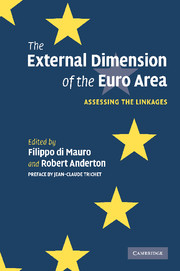Book contents
- Frontmatter
- Contents
- List of illustrations
- List of contributors
- Preface by Jean-Claude Trichet
- 1 Introduction
- 2 The external dimension of the euro area: stylised facts and initial findings
- 3 Product variety and macro trade models: implications for the new EU Member States
- 4 Exchange-rate pass-through to import prices in the euro area
- 5 The international equity holdings of euro area investors
- 6 Global linkages through foreign direct investment
- 7 Shocks and shock absorbers: the international propagation of equity market shocks and the design of appropriate policy responses
- 8 The euro area in the global economy: its sensitivity to the international environment and its influence on global economic developments
- Index
- References
7 - Shocks and shock absorbers: the international propagation of equity market shocks and the design of appropriate policy responses
Published online by Cambridge University Press: 22 September 2009
- Frontmatter
- Contents
- List of illustrations
- List of contributors
- Preface by Jean-Claude Trichet
- 1 Introduction
- 2 The external dimension of the euro area: stylised facts and initial findings
- 3 Product variety and macro trade models: implications for the new EU Member States
- 4 Exchange-rate pass-through to import prices in the euro area
- 5 The international equity holdings of euro area investors
- 6 Global linkages through foreign direct investment
- 7 Shocks and shock absorbers: the international propagation of equity market shocks and the design of appropriate policy responses
- 8 The euro area in the global economy: its sensitivity to the international environment and its influence on global economic developments
- Index
- References
Summary
Introduction
Equity prices and equity markets are major sources of shocks to the world economy and major channels for the propagation of these shocks. In this chapter we seek to calibrate their effects, and assess what policy responses can best absorb them. We first briefly discuss the evidence for the effects of equity prices on real economic activity and look at some evidence on the relationship between equity prices and output using Vector Error Correction (VECM) Models. We compare these results for the US and the major euro area countries to those produced using the National Institute Global Econometric Model (NiGEM). We assess the implications of equity price falls comparable to those seen in 2000–2002 in the context of NiGEM, presenting a range of simulations on the model. These give a view of the macroeconomic impact of equity market falls, viewed in the context of the high degree of correlation between equity price changes in the recent past, and also give an indication of the effect of differing policy responses.
The macroeconomic importance of equity markets
There is a significant literature investigating the impact of wealth – itself driven partly by share prices – on consumption. Davis and Palumbo's (2001) study of the US consumption function attempts to determine whether changes in wealth affect the growth rate of consumer spending. They examined quarterly aggregate US data from 1960–2000 and modelled long-run relationships to investigate whether (logged) consumption, income and wealth share a common trend.
- Type
- Chapter
- Information
- The External Dimension of the Euro AreaAssessing the Linkages, pp. 146 - 172Publisher: Cambridge University PressPrint publication year: 2007
References
- 1
- Cited by



